Effect of Grain Refiner on Fracture Toughness of 7050 Ingot and Plate
Abstract
:1. Introduction
2. Materials and Methods
3. Results
3.1. The Effect of Grain Refiner on 7050 Ingot Grain Size
3.2. The Effect of Grain Refiner on Tensile Property of 7050 Ingot and 7050-T7651 100 mm Plate
3.3. Effect of Different Grain Refiners on Fracture Toughness of 7050 Ingot and Plate
4. Discussion
5. Conclusions
Author Contributions
Funding
Institutional Review Board Statement
Informed Consent Statement
Data Availability Statement
Conflicts of Interest
References
- Staley, J.T.; Liu, J.; Hunt, H.W. Aluminum alloys for aerostructures. Adv. Mater. Process. 1997, 152, 10–17. [Google Scholar]
- Yang, S.J.; Dai, S.L. A glimpse at the development and application of aluminum alloys in aviation industry. Mater. Rev. 2005, 2, 76–80. [Google Scholar]
- Deng, Y.L.; Zhang, X.M. Development of Aluminum and Aluminum alloy. Chin. J. Nonferr. Met. 2019, 9, 2115–2141. [Google Scholar]
- Ji, H. Development and application of 700 high strength aluminum alloys on airplane. Aeronaut. Sci. Technol. 2015, 6, 75–78. [Google Scholar]
- Hahn, G.T.; Rosenfield, A.R. Metallurgical Factors Affecting Fracture Toughness of Aluminum Alloys. Metall. Trans. A 1975, 6A, 653–668. [Google Scholar] [CrossRef]
- Starke, E.A.; Staley, J.T. Application of modern aluminum alloys to aircraft. Prog. Aerospace Sci. 1996, 747–783. [Google Scholar] [CrossRef]
- Deshpande, N.U.; Gokhale, A.M.; Denzer, D.K.; Liu, J. Relationship Between Fracture Toughness, Fracture Path and Microstructure of 7050 Aluminum Alloy: Part 1. Quantitative Characterization. Metall. Mater. Trans. A 1998, 29, 1191–1201. [Google Scholar] [CrossRef]
- Morere, B.; Ehrstrom, J.C.; Gregson, P.J.; Sinclair, I. Microstructural Effects on Fracture Toughness in AA7010 Plate. Metall. Mater. Trans. A 2000, 31, 2503–2515. [Google Scholar] [CrossRef]
- Qin, C.; Gou, G.Q.; Chen, X.L.; Chen, H. Effect of alloying elements on mechanical property and fracture of A7N01S-T5 aluminum alloy. Chin. J. Mater. Res. 2015, 7, 535–541. [Google Scholar]
- Zhang, X.M.; He, D.G.; Liu, S.D.; Han, N.M.; Zhang, R. Effects of multi-stage promotively-solutionizing treatment on strength and fracture toughness of 7050 aluminum alloy thick plate. Chin. J. Nonferr. Met. 2012, 22, 1546–1552. [Google Scholar]
- Dumont, D.; Deschamps, A.; Brechet, Y. On the relationship between microstructure, strength and toughness in AA7050 aluminum alloy. Mater. Sci. Eng. A 2003, 356, 326–336. [Google Scholar] [CrossRef]
- Chen, S.Y.; Chen, K.H.; Dong, P.X.; Ye, S.P.; Huang, L.P. Effect of heat treatment on stress corrosion cracking, fracture toughness and strength of 7085 aluminum alloy. Trans. Nonferr. Met. Soc. Chin. 2014, 24, 2320–2325. [Google Scholar] [CrossRef]
- Chen, G.H.; Li, G.A.; Chen, J.Z.; Gang, R.J.; Wei, W.H. Effect of rolling microstructure characteristics on fracture toughness of 7B50-T7751 aluminum alloy thick plate. Light Alloy Fabr. Technol. 2018, 6, 29–33. [Google Scholar]
- Wu, L.M.; Wang, W.H.; Hsu, Y.F.; Shan, T. Effects of homogenization treatment on recrystallization behavior and dispersoid distribution in an Al-Zn-Mg-Sc-Zr alloy. J. Alloys Compd. 2008, 456, 163–169. [Google Scholar] [CrossRef]
- Han, N.M.; Zhang, X.M.; Liu, S.D.; Huang, L.Y.; Xin, X.; He, D.G. Effects of retrogression and re-aging on strength and fracture toughness of aluminum alloy 7050. Chin. J. Nonferr. Met. 2012, 7, 1871–1882. [Google Scholar]
- Schneider, W.; Keaens, M.A.; Mcgarry, M.J.; Whitehead, A.J. A Comparison of the Behaviour of AlTiB and AlTiC Grain Refiners. Light Metals 1998, 3, 400–408. [Google Scholar]
- Hiromi, N.; Guo, S.J.; Xue, G.X.; Ke, M.H. Effect of grain refiner on microstructure of 7050 aluminum alloy with casting temper. Light Alloy Fabr. Technol. 2012, 20, 27–43. [Google Scholar]
- Huang, Y.C.; Du, Z.Y.; Xiao, Z.B.; Yan, X.X. Effect of Al-Ti-C and Al-Ti-B on Microstructure and Mechanical performance of 7050 Aluminum alloy. J. Mater. Eng. 2015, 43, 75–80. [Google Scholar]
- Liu, M. Development overview of grain refinement for aluminum alloys. Foundry Tech. 2018, 39, 2429–2432. [Google Scholar]
- Liu, L.Y.; Sun, B.H.; Han, Y. Study on Morphology of Al-5Ti-1B Master Alloy and Its Effect on Grain Refinement of Aluminum Alloy. Alum. Processing. 2019, 2, 15–18. [Google Scholar]
- Hu, Y.J.; Zhong, J.Y.; Zhang, Y.L. Effect of Al-Ti-C and Al-Ti-B wire rod on grain of aluminum alloy flat ingot. Light Alloy. Fabr. Technol. 2007, 10, 7–8. [Google Scholar]
- Mostafa, A.; Adaileh, W.; Awad, A.; Kilani, A. Mechanical Properties of Commercial Purity Aluminum Modified by Zirconium Micro-Additives. Crystals 2021, 11, 270. [Google Scholar] [CrossRef]
- ASTM International. ASTM E112-13. Standard Test Methods for Determining Average Grain Size. In ASTM Book of Standards; ASTM International: West Conshohocken, PA, USA, 2013. [Google Scholar]
- SAE International AMS2355. Quality Assurance, Sampling and Testing Aluminum Alloys and Magnesium Alloy Wrought Products (Except Forging Stock), and Rolled, Forged, or Flash Welded Rings. In Aerospace Material Specification; SAE International: Warrendale, PA, USA, 2017. [Google Scholar]
- Zhang, X.M.; Han, N.M.; Liu, S.D. Inhomogeneity of texture, tensile property and fracture toughness of 7050 aluminum alloy thick plate. Chin. J. Nonferr. Met. 2020, 20, 202–207. [Google Scholar]
- Teleshov, V.V.; Shtovba, Y.K.; Smolentsev, V.I.; Sirotkina, O.M. Effect of grain size on the fracture toughness and strength of alloy AK4-1ch. Met. Sci. Heat Treat. 1993, 25, 29–34. [Google Scholar] [CrossRef]
- Krasovskii, A.Y. Brittleness of Metals at Low Temperature. Naukova Dumka 1980, 13, 340. [Google Scholar]
- Gokhale, A.M.; Deshpande, N.U.; Denzer, D.K. Relationship Between Fracture Toughness, Fracture Path, and Microstructure of 7050 Aluminum Alloy Part II. Multiple Micro-mechanisms-Based Fracture Toughness Model. Metall. Mater. Trans. A 1998, 29, 1203–1210. [Google Scholar] [CrossRef]
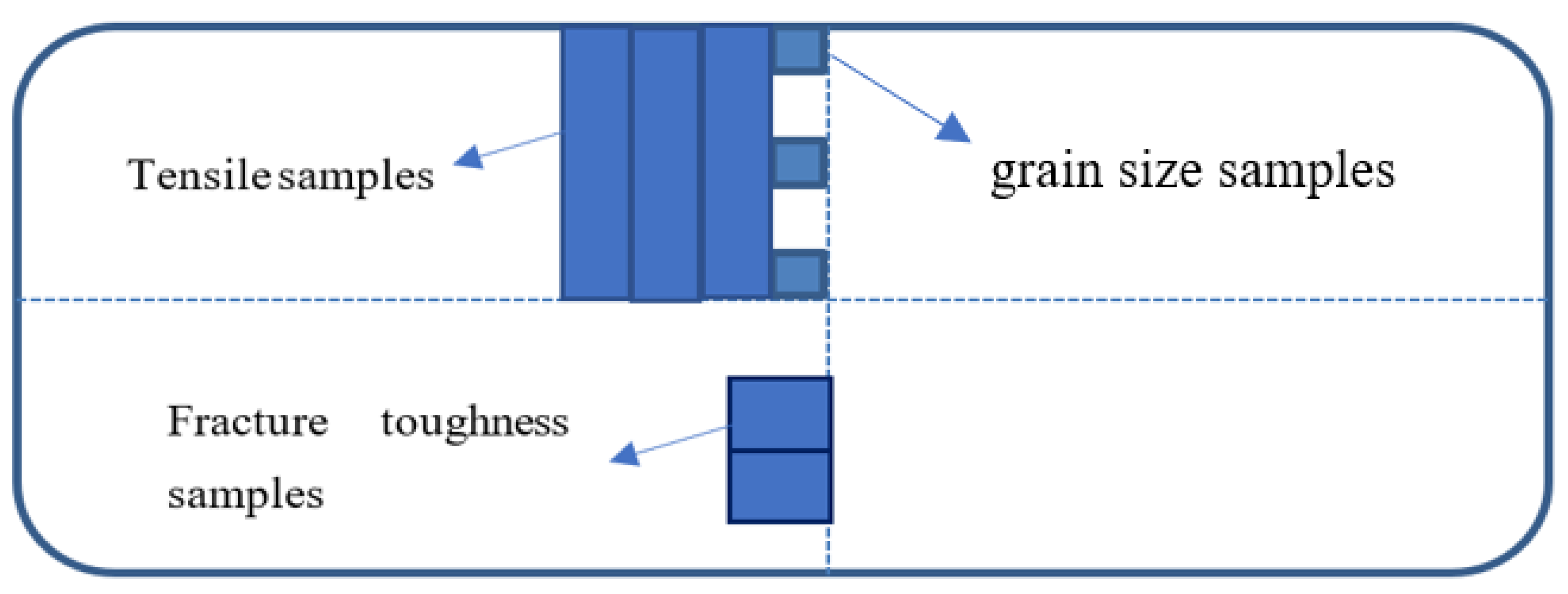
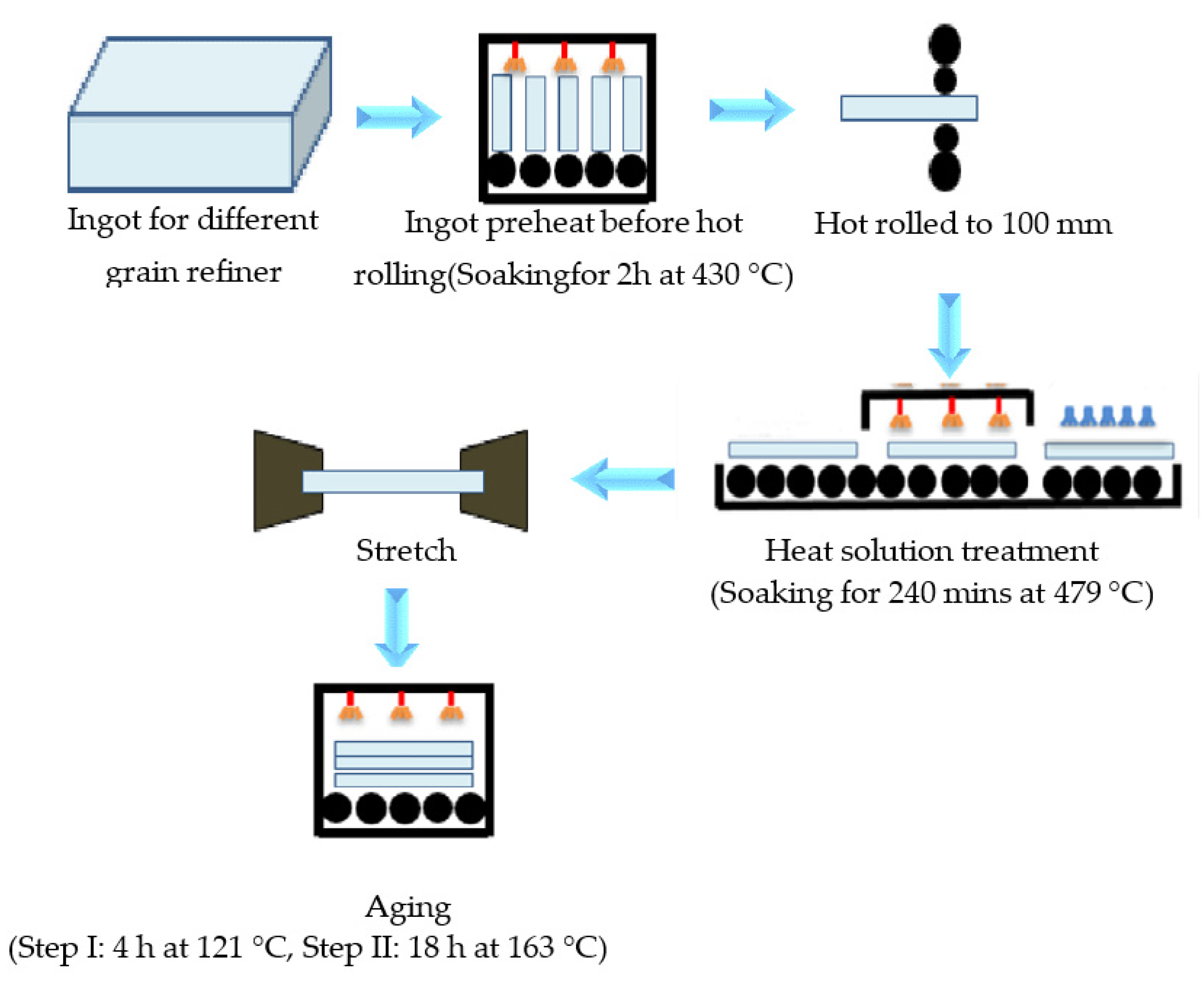

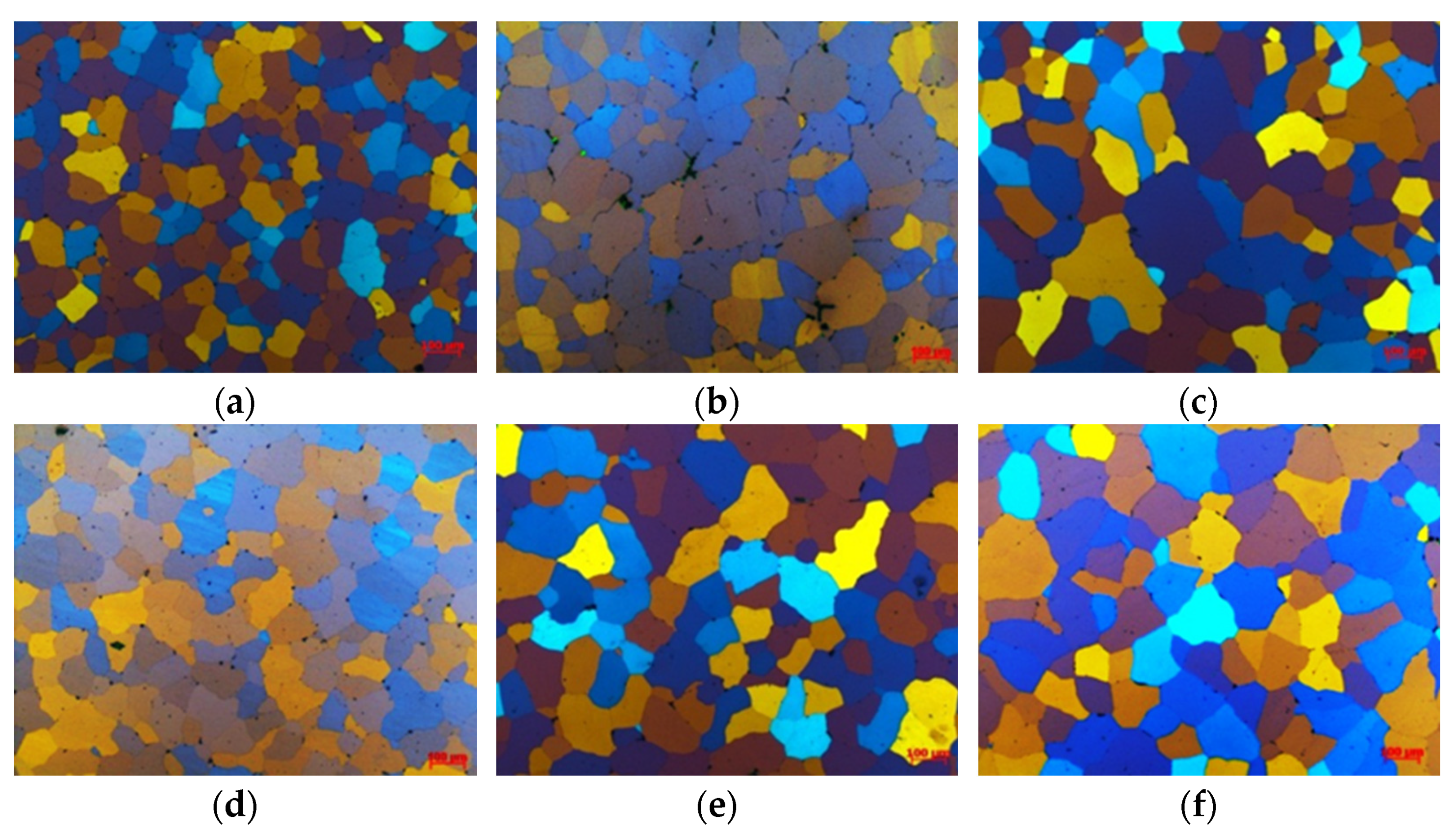
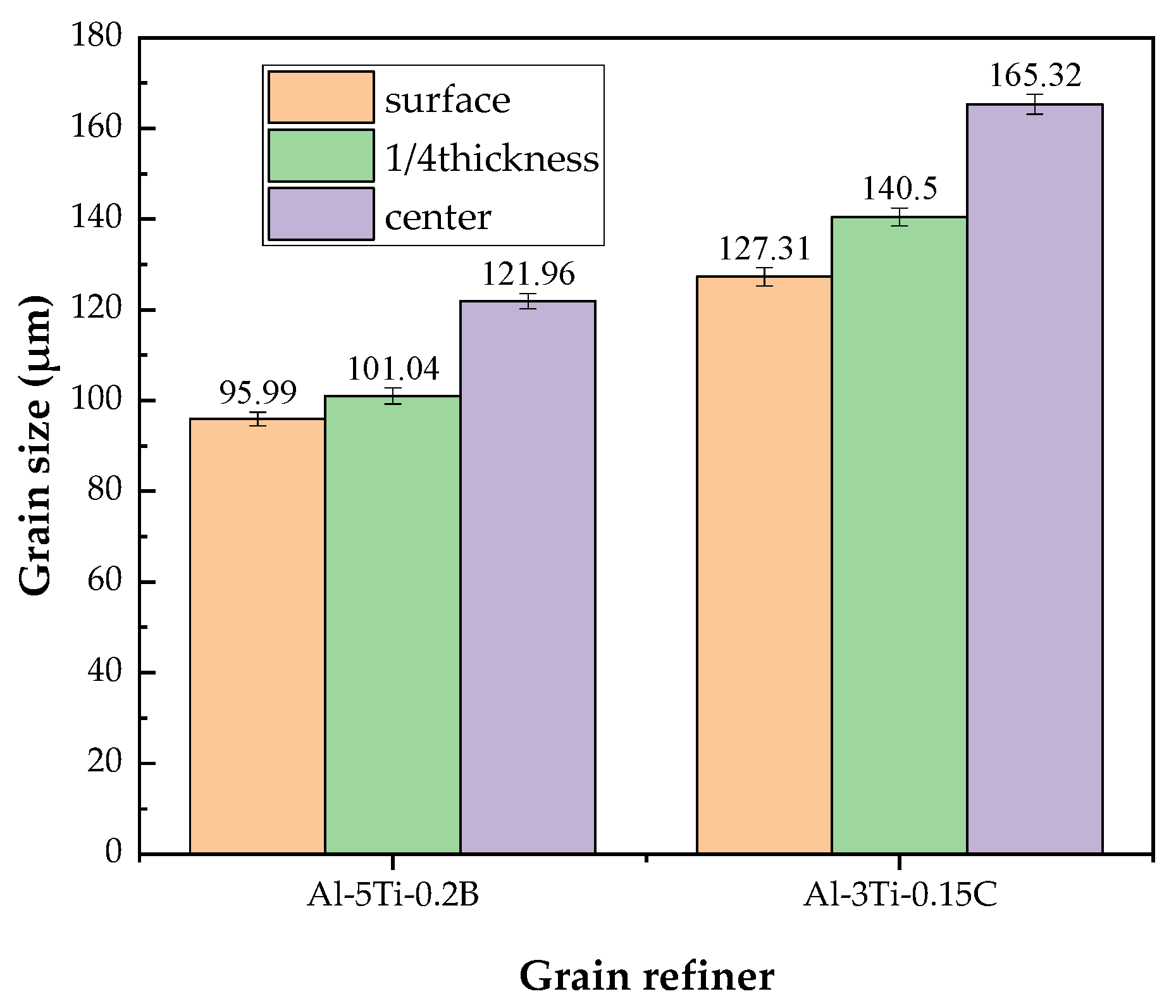
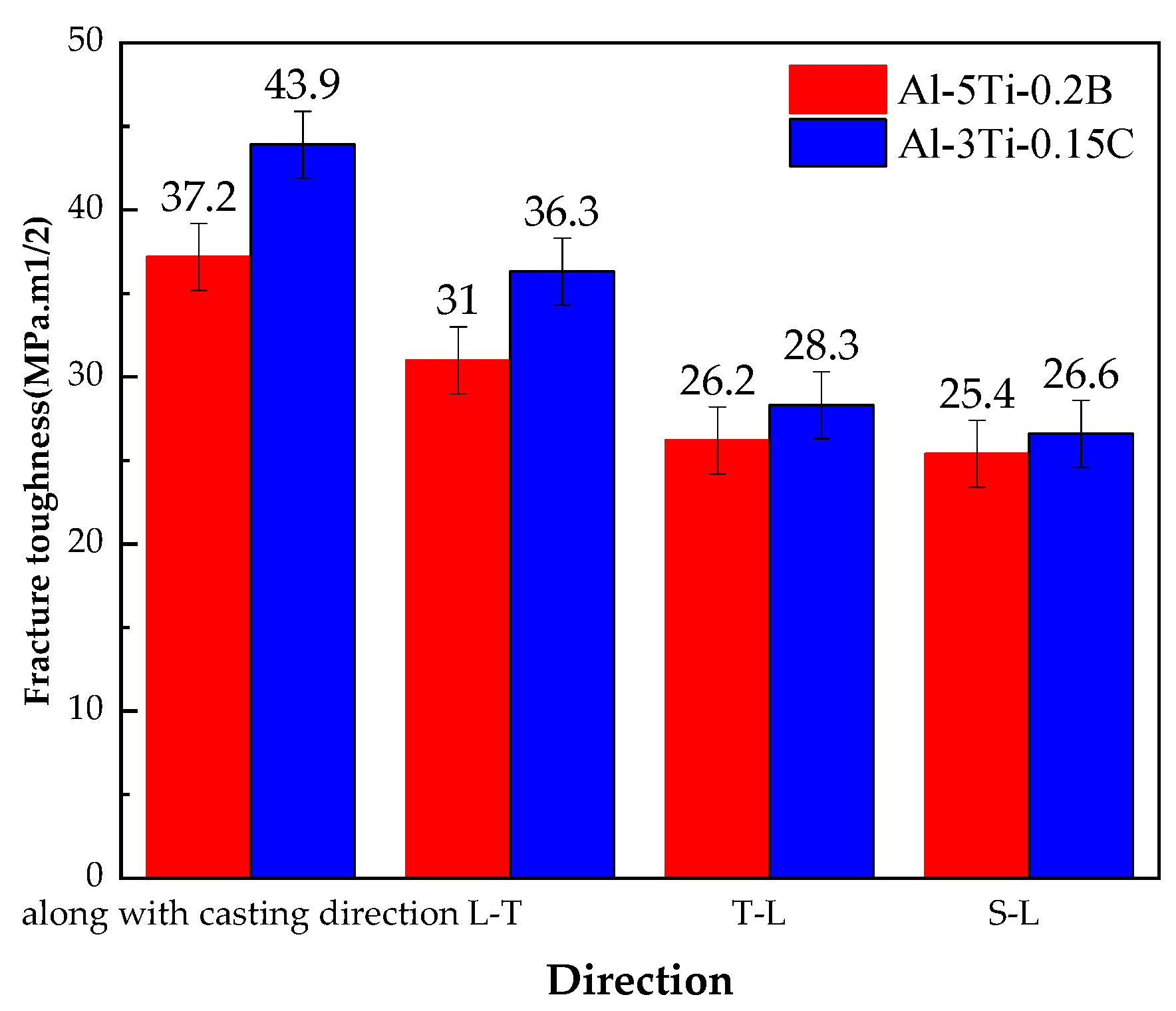
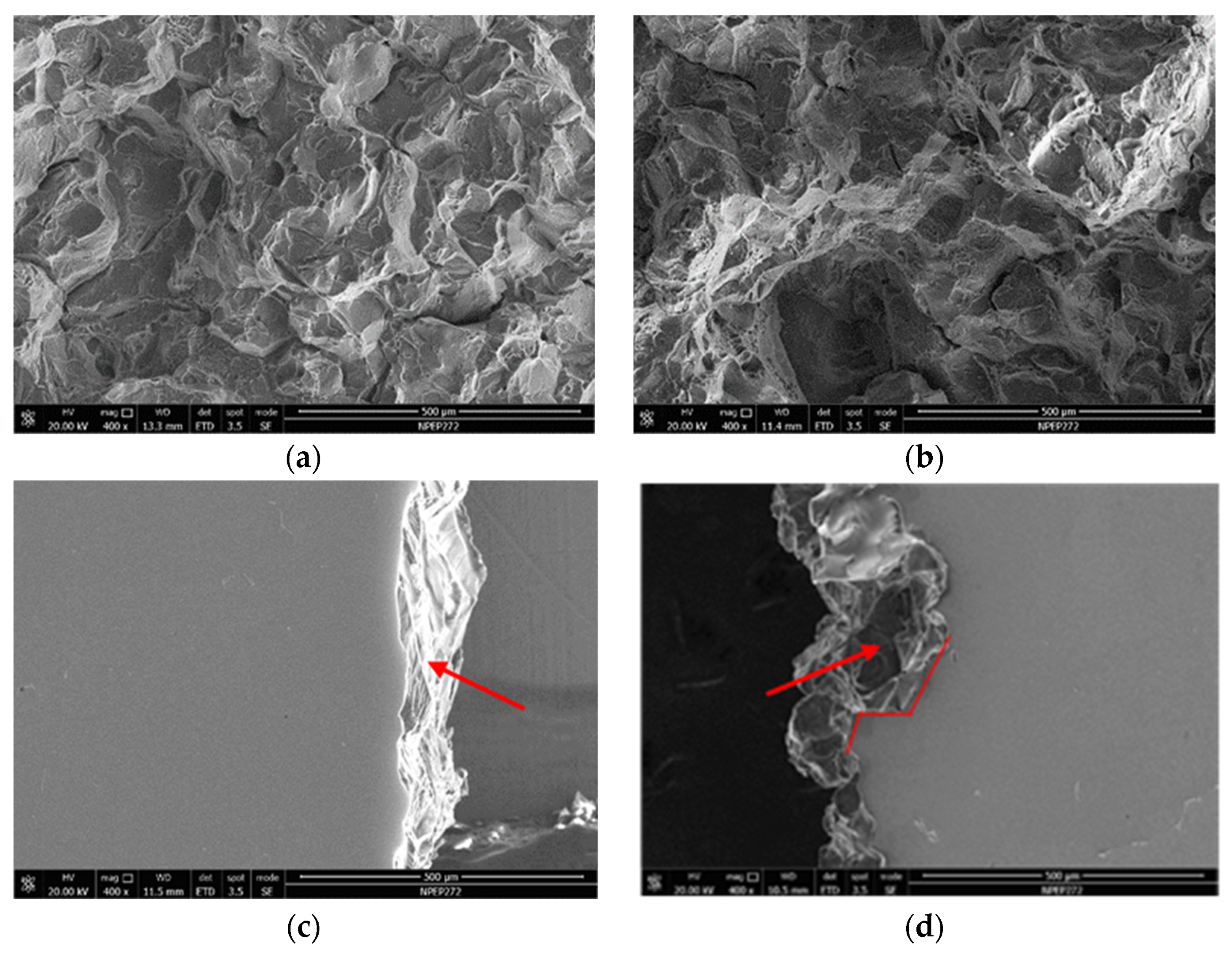
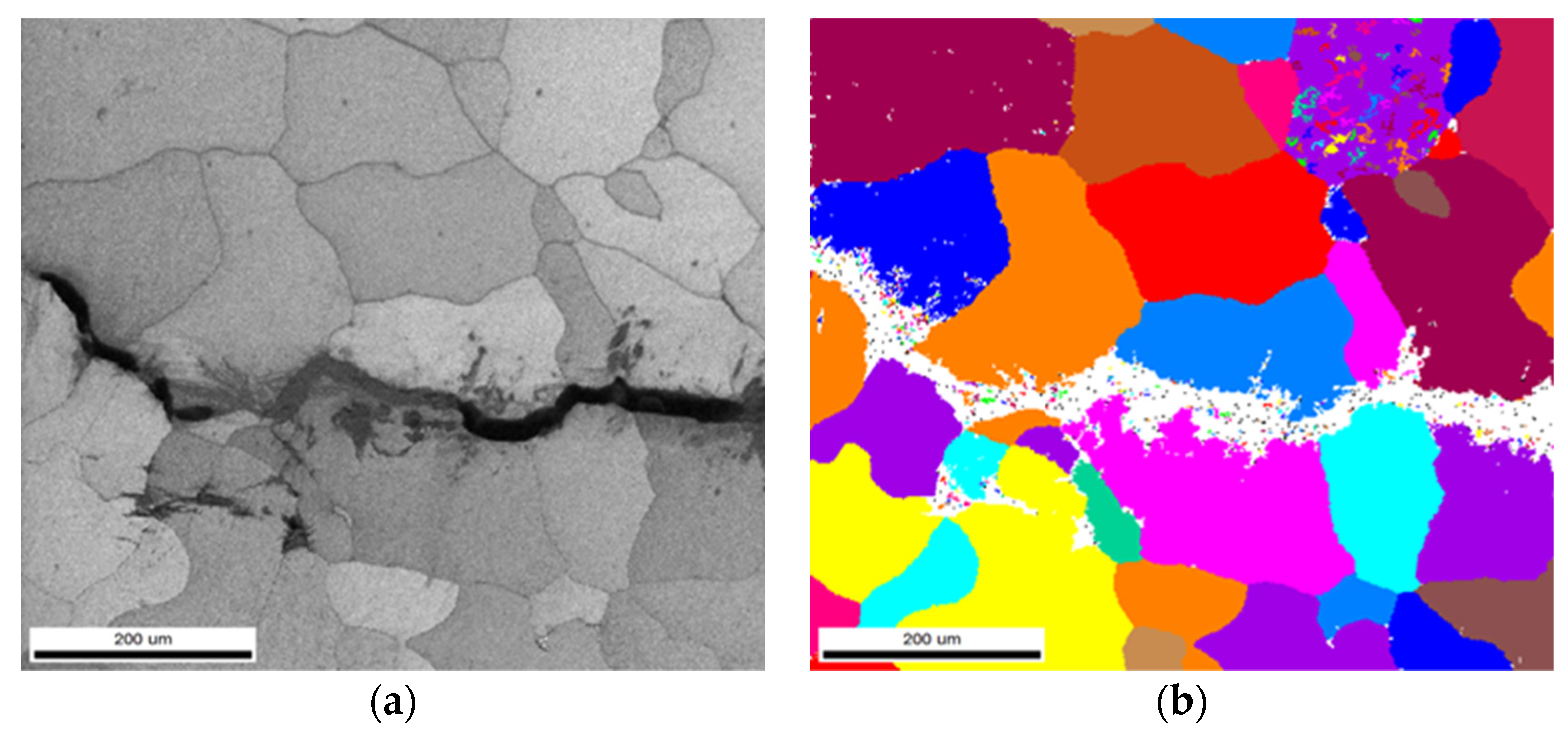


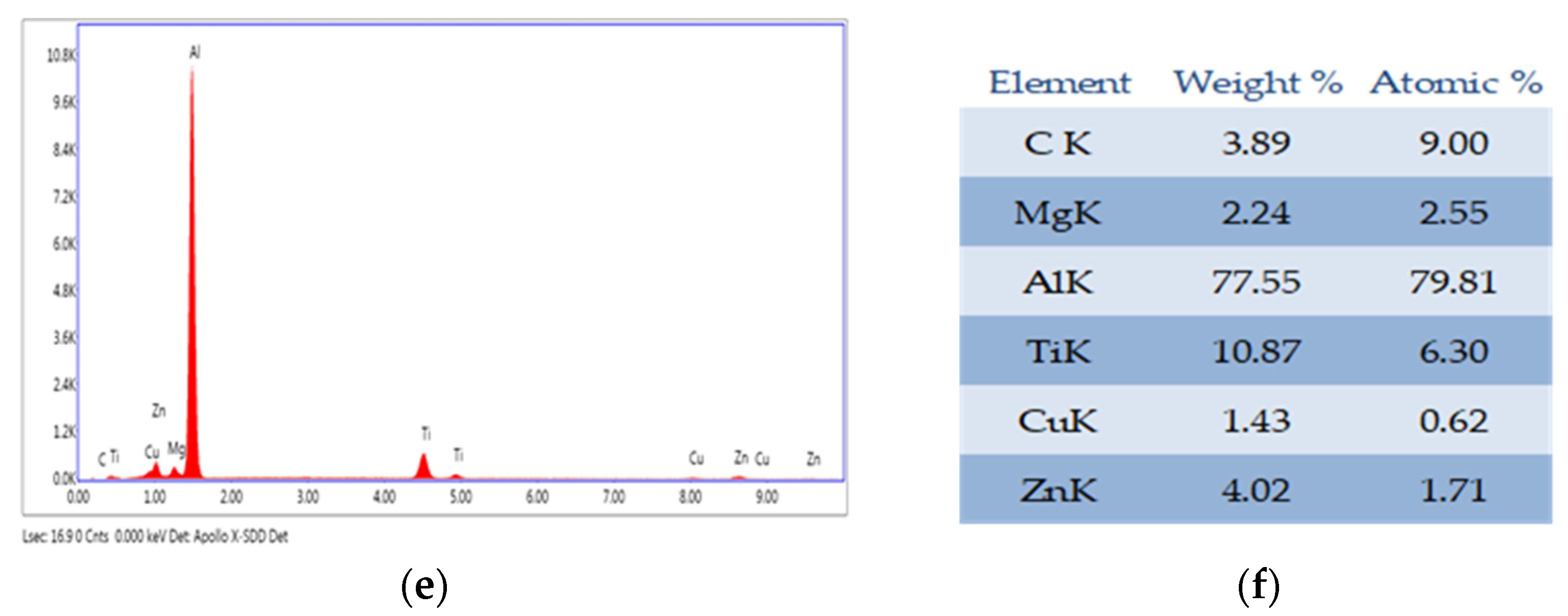
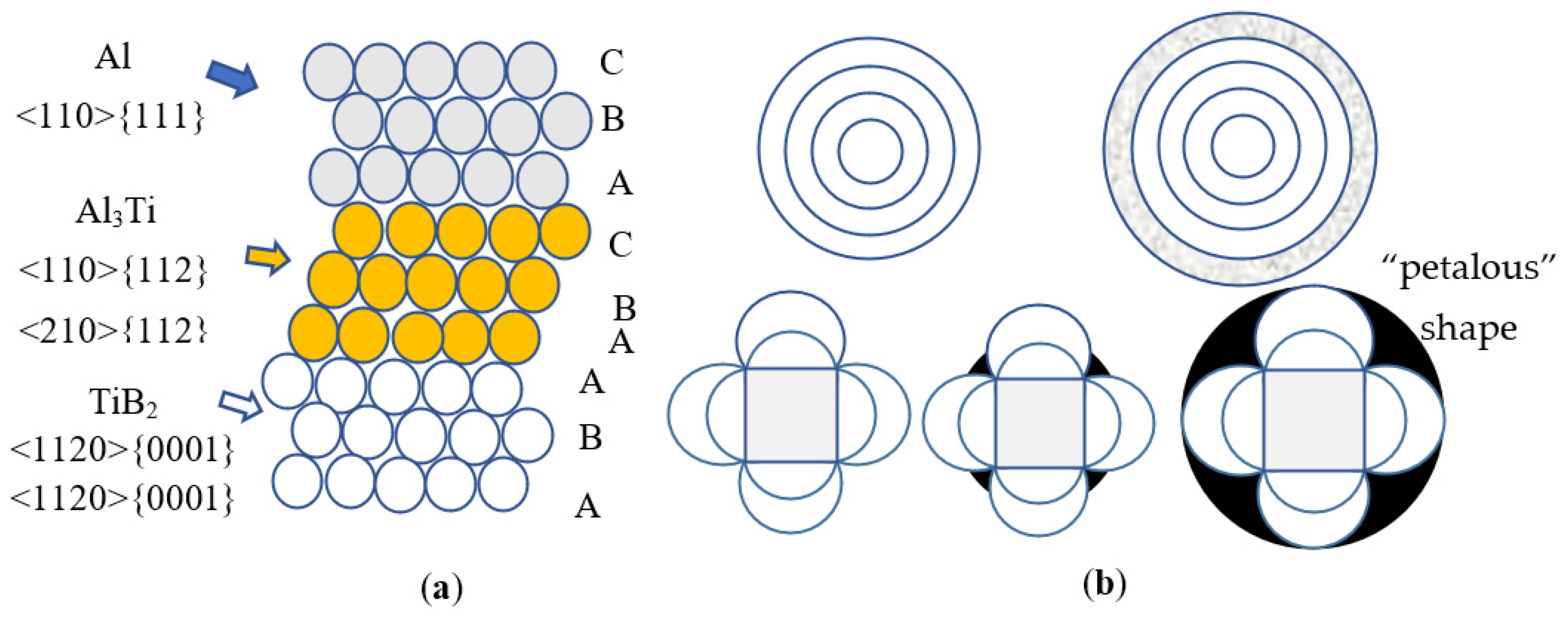

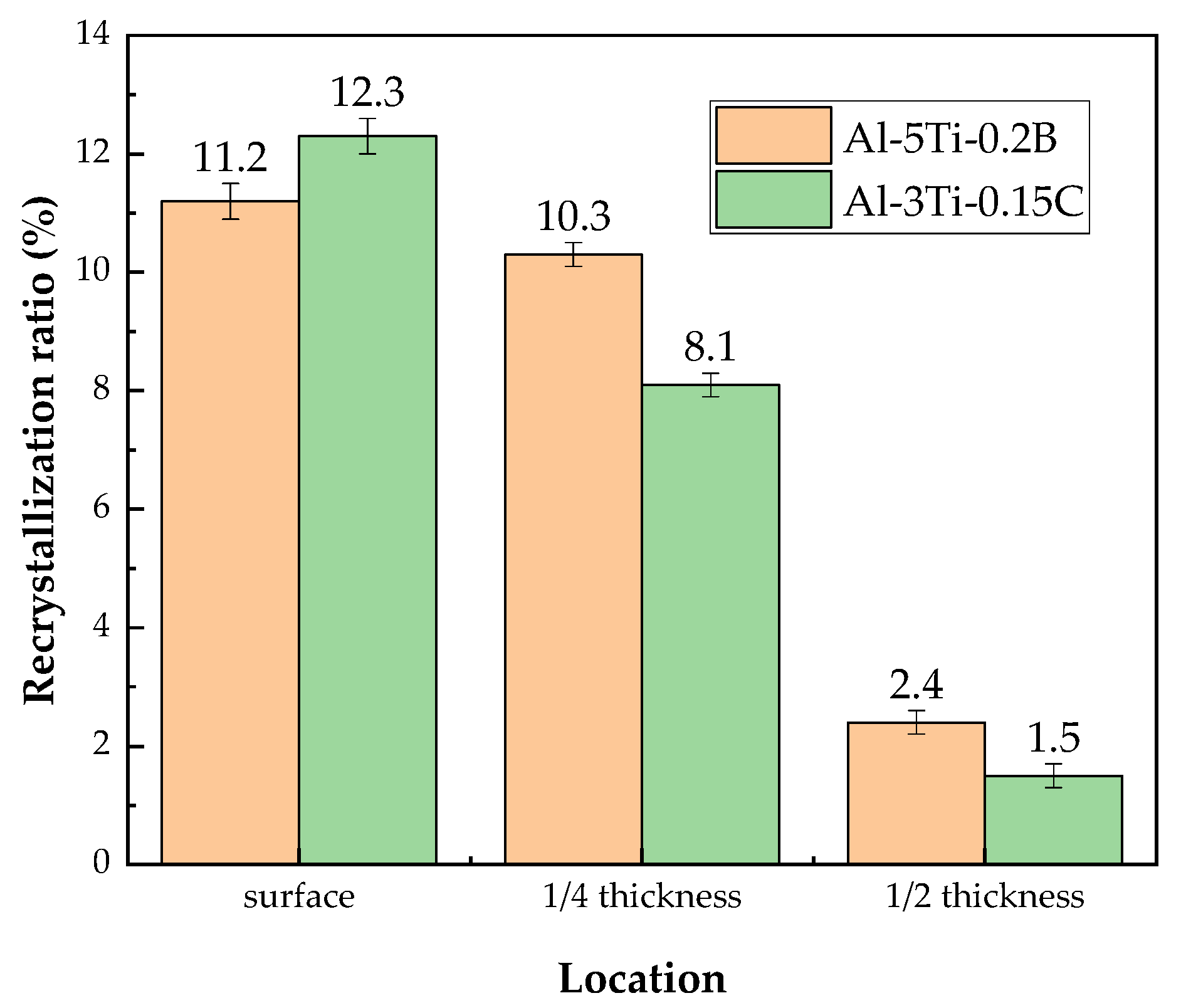
| Si | Fe | Cu | Mn | Mg | Cr | Zn | Ti | Zr | Al |
|---|---|---|---|---|---|---|---|---|---|
| 0.08 | 0.10 | 2.2 | 0.10 | 2.15 | 0.02 | 6.2 | 0.06 | 0.10 | remainder |
| Grain Refiner | Ultimate Strength (MPa) | Yield Strength (MPa) | Elongation (%) |
|---|---|---|---|
| Al-5Ti-0.2B | 531.0 ± 1.04 | 474.5 ± 0.50 | 6.0 ± 0.50 |
| Al-3Ti-0.15C | 529.5 ± 0.50 | 473.6 ± 0.76 | 7.5 ± 0.50 |
| Direction | Al-5Ti-0.2B | Al-3Ti-0.15C | ||||
|---|---|---|---|---|---|---|
| Ultimate Strength (MPa) | Yield Strength (MPa) | Elongation % | Ultimate Strength (MPa) | Yield Strength (MPa) | Elongation % | |
| L | 532.0 ± 1.44 | 485.8 ± 2.70 | 11.3 ± 0.55 | 522.8 ± 2.44 | 470.5 ± 2.81 | 12.8 ± 0.34 |
| LT | 543.3 ± 1.91 | 482.6 ± 3.01 | 9.6 ± 0.45 | 529.7 ± 1.37 | 464.0 ± 2.06 | 10.5 ± 0.34 |
| ST | 531.2 ± 0.47 | 449.7 ± 0.24 | 7.6 ± 0.24 | 523.5 ± 0.63 | 438.9 ± 1.86 | 8.8 ± 0.69 |
Publisher’s Note: MDPI stays neutral with regard to jurisdictional claims in published maps and institutional affiliations. |
© 2021 by the authors. Licensee MDPI, Basel, Switzerland. This article is an open access article distributed under the terms and conditions of the Creative Commons Attribution (CC BY) license (https://creativecommons.org/licenses/by/4.0/).
Share and Cite
Yu, F.; Wang, X.; Huang, T.; Chao, D. Effect of Grain Refiner on Fracture Toughness of 7050 Ingot and Plate. Materials 2021, 14, 6705. https://doi.org/10.3390/ma14216705
Yu F, Wang X, Huang T, Chao D. Effect of Grain Refiner on Fracture Toughness of 7050 Ingot and Plate. Materials. 2021; 14(21):6705. https://doi.org/10.3390/ma14216705
Chicago/Turabian StyleYu, Fang, Xiangjie Wang, Tongjian Huang, and Daiyi Chao. 2021. "Effect of Grain Refiner on Fracture Toughness of 7050 Ingot and Plate" Materials 14, no. 21: 6705. https://doi.org/10.3390/ma14216705





